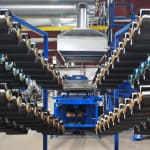 PlastiComp, Inc. announced it has completed installation of an additional pultrusion line dedicated to manufacturing long carbon fiber reinforced thermoplastic composite pellets at its Winona, Minn., location. The firm brought its initial production line dedicated to producing long carbon fiber composite pellets online in 2014 and operates four other pultrusion lines to manufacture its long glass fiber products.
PlastiComp, Inc. announced it has completed installation of an additional pultrusion line dedicated to manufacturing long carbon fiber reinforced thermoplastic composite pellets at its Winona, Minn., location. The firm brought its initial production line dedicated to producing long carbon fiber composite pellets online in 2014 and operates four other pultrusion lines to manufacture its long glass fiber products."In recent years we have experienced continuous growth in demand for our long carbon fiber reinforced composite materials," said Eric Wollan, Vice President and Chief Operating Officer at PlastiComp. "This additional, higher volume carbon fiber pultrusion line will triple PlastiComp's capacity for producing long carbon fiber products to ensure an uninterruptable supply chain for our partners."
To provide a safe operating environment and minimize downtime, PlastiComp manufactures its carbon fiber composites on pultrusion lines located in self-contained areas equipped with isolated electrical and air handling systems.
"From a pultrusion perspective, carbon fiber's small filament diameter and conductivity makes ita little more challenging to manufacture composite pellets than other types of fiber," said Wollan. "Using our specialized equipment, PlastiComp is able to completely melt impregnate continuous tows of carbon fiber with 12,000 to 50,000 filaments. This capability allows us to offer a broad range of composite material solutions which we tailor to meet customer specific design and performance requirements."
Long carbon fiber reinforced thermoplastic composites provide the strongest and stiffest performance available in flowable materials suitable for injection molding processing. PlastiComp manufactures composite pellets under its Complēt trade name with 15 to 50 weight-percent long carbon fiber reinforcement combined into a broad range of thermoplastic matrices ranging from polypropylene to PEEK.
The firm also has a long fiber composites product line that combine glass fiber and carbon fiber together into a single pellet solution. PlastiComp's hybrid long glass+carbon products bridge the performance and price gap between all-glass fiber and all-carbon fiber reinforced composite materials.
Often selected for its high strength-to-weight ratio- making it an ideal material choice for applications with structural requirements that also need to be lightweight - long carbon fiber composites offer mechanical performance equivalent to aluminum while providing design dependent weight reductions up to 50%.
Thermoplastic materials incorporating carbon fiber reinforcement are conductive (<10E5 ohms-per-square) giving them excellent surface and volume resistivity propertiesand up to 80 decibels (dB) of shielding effectiveness against electromagnetic interference.
Carbon fiber's extensive use in aerospace and other advanced industries has given it a "high-tech" perception which other markets are now taking advantage of to promote their products to consumers. Initiatives to replace metals forweight reduction have made materials containing carbon fiber a favorite of sporting goods manufacturers where it helps reduce participant fatigue, and the transportation sector where it lowers vehicle mass to increase fuel economy and curtail engine emissions.


